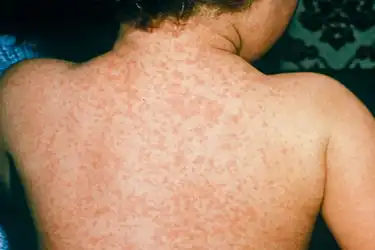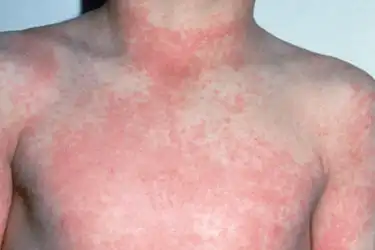Baby Symptoms Red Face Cold Hands Irritability and Loss of Sleep

While vaccines have made some childhood illnesses rare, many others remain a fact of life. They range from mutual infections like croup to mysterious ailments like Kawasaki disease. In the following slides, you'll learn the facts about two dozen babyhood illnesses. Merely be sure to consult your pediatrician for proper diagnosis and treatment.

RSV stands for respiratory syncytial virus, and it'south the top cause of bronchiolitis (inflammation of the small airways) and pneumonia in U.S. infants. The infection begins with flu-like symptoms, including a fever, runny nose, and cough. Up to 40% of young children with their beginning RSV infection will develop noticeable wheezing, and up to 2% volition require hospitalization. RSV tends to be milder in older kids and adults.

Young children are prone to ear infections because of their small and horizontally positioned auditory tubes. These tubes connect the ears to the throat, and they may get blocked when a cold causes inflammation. This traps fluid within the middle ear, backside the eardrum, allowing germs to breed. The symptoms include fever, fussiness, and ear-pulling. Many ear infections are due to viruses and become abroad on their ain. Babyhood vaccinations help prevent infections from sure bacteria that tin cause ear infections. And some ear infections crave treatment with an antibiotic.

A buildup of fluid in the middle ear (either with or without any pain) is called otitis media with effusion, or OME. It ofttimes follows an astute ear infection or upper respiratory infection. The fluid unremarkably clears upward on its own within a couple weeks. Nonetheless, if it lingers or is thick and glue-like ("Glue Ear"), it tin can interfere with a child'south hearing. Your doctor may suggest a referral to a specialist if your kid has recurrent ear infections or gum ear. For some infections, ear tubes may be recommended to help the fluid drain.

The hallmark of croup is a tight cough that occurs predominantly at night and sounds like a barking seal. The crusade of the cough is inflammation in the upper airways, usually due to a virus. If breathing becomes severely impaired, infirmary treatment may be needed. However, nigh kids get meliorate on their ain in about a calendar week. Croup is near mutual in children under five.

Paw-foot-and-mouth illness causes a fever along with blisters on the within of the mouth, the palms of the easily, the buttocks, and the soles of the feet. In the U.S., it is usually acquired by coxsackievirus A16. This virus tends to spread amongst children during summertime and early autumn. Nigh cases are non serious and terminal a calendar week to x days.

Vehement, redness, itching, and crusty eyelashes are all signs of conjunctivitis, commonly chosen pinkeye. Often acquired past the same viruses as the mutual cold, pinkeye spreads speedily in schools and day care centers. Consult your pediatrician to make up one's mind whether your child needs treatment. Most cases clear up in four to seven days.

Oftentimes called "slapped cheek" disease, fifth affliction causes a bright red rash on a child'southward face. A rash may as well appear on the torso, artillery, or legs. The culprit is homo parvovirus B19, a virus that may cause mild cold-like symptoms earlier the rash is seen. Once the rash appears, the kid is unremarkably no longer contagious. Upwardly to 20% of kids get it past historic period 5, and up to threescore% have had it by historic period nineteen. The rash usually disappears in seven to 10 days.

Before the introduction of an effective vaccine, rotavirus was the top cause of diarrhea-related deaths in young children. The primary symptoms are vomiting and watery diarrhea, which can make babies get dehydrated very quickly. There are at present ii rotavirus vaccines for infants, and studies betoken a dramatic drop in the number of new cases.

Kawasaki affliction is a very rare and mysterious ailment that strikes children under age 5. The symptoms include a high and prolonged fever (lasting more than v days), patchy rash, swelling and redness of the easily and anxiety, bloodshot optics, and chapped, red lips. Without treatment, the illness can damage the heart and may be fatal. Doctors have even so to detect what causes Kawasaki disease.

One time a very itchy rite of passage, chickenpox is now preventable through the varicella vaccine. The reasons for vaccination go beyond sparing your kid the uncomfortable red blisters. Chickenpox can cause dangerous complications in newborns, adults, and pregnant women. Before the vaccine, chickenpox sent eleven,000 Americans to the hospital every yr.

If your kids are up-to-date on their vaccines, you probably don't take to worry about measles. But the CDC has reported outbreaks, which tin be very contagious amongst unvaccinated children. The infection starts with a fever, runny nose, and cough. As these symptoms fade, a full-body rash appears. Most kids get better in two weeks, just some develop pneumonia or other problems.

Mumps is some other childhood illness that was very mutual before a vaccine was developed. The infection often causes no symptoms, but when it does, the classic sign is swollen glands between the ear and jaw. This creates the appearance of "chipmunk cheeks." Despite high vaccination rates, recent outbreaks have infected thousands of people in the U.S. Unvaccinated individuals are 9 times more probable to catch mumps.

Rubella, besides called German measles, is a mild virus that unremarkably causes no serious problems. Nevertheless, it tin can harm the fetus if a pregnant woman becomes infected. The symptoms are a low fever and rash that spreads from the confront to the residuum of the body. A standard babyhood vaccine called MMR protects confronting measles, mumps, and rubella.

Whooping coughing makes children coughing then difficult, they run out of breath and inhale with a "whoop." The infection is almost severe in infants and may require hospital treatment. The medical term for the disease is pertussis -- the "P" in the DTaP vaccine. Antibiotics are non especially helpful in treatment, so vaccination is essential for prevention. Adults demand a booster, and significant women need a booster with every pregnancy.

Meningitis is an inflammation or infection of the tissue around the brain and spinal cord. In teens and adults, the main symptoms are headache, fever, and stiff neck. Immature children may accept influenza-like symptoms or extreme irritability. Viral meningitis is usually mild, only bacterial meningitis is more severe with serious consequences if it isn't treated rapidly. Vaccines are bachelor to prevent certain bacterial causes of meningitis.

Most kids get a sore throat at present and and so, usually due to a cold virus. So how can you lot tell if it's caused by the strep bacteria? Sneezing or a runny nose point to a cold. Signs of strep include a sore pharynx with a headache that lasts more a week, painful or difficult swallowing, excessive drooling, a rash, pus in the back of the throat, fever over 100.four degrees, or contact with someone with strep throat. Strep pharynx is treated with antibiotics.

Sometimes a rough, red rash accompanies strep throat. This is known as ruby fever. The rash begins on the breast and abdomen and spreads all over the body, accompanied by a strawberry-looking natural language and loftier fever. Without treatment, any strep infection can lead to rheumatic fever and, in rare cases, heart damage. That's why carmine fever was in one case a dreaded babyhood illness. Today, it is hands cured with antibiotics.

You lot've probably heard you should never give aspirin to children or teens. Reye's syndrome is the reason. This life-threatening condition may strike kids who take medications containing aspirin during a viral affliction. Symptoms include dramatic behavior changes, seizures, and blackout. Reye's syndrome has go very rare since the CDC warned confronting giving aspirin to children.

MRSA is a type of staph bacteria that doesn't respond to some antibiotics. Doctors say MRSA is now the meridian crusade of skin infections. These infections commonly appear in the course of sores or boils and may wait like a spider seize with teeth. MRSA ear, nose, and throat infections are likewise on the ascension in elementary schoolhouse children.

Impetigo is another bacterial skin infection. Information technology about commonly causes clusters of tiny blisters on the skin that ooze and class a gilt crust. Touching the fluid can spread the infection to other parts of the body or other people. It is often caused past staph bacteria but also can exist caused past strep bacteria. This type of impetigo is most common in kids ages ii to 6. If treated with antibiotics, the sores usually heal without leaving scars.

Even so some other pare infection, ringworm is really caused past a fungus -- no worms involved. It causes a red, scaly ring on the skin or a round patch of hair loss on the scalp. The mucus spreads easily from child to child, and then sharing combs, brushes, towels, and dress should exist avoided. Ringworm is treated with antifungal medication.

The hallmark of Lyme affliction is a target-shaped rash that appears 1-2 weeks later a tick seize with teeth, though not everyone volition develop the distinctive rash. The rash may be accompanied past a fever, chills, and trunk aches. The culprit is a blazon of bacterium carried past tiny deer ticks. Without handling, Lyme illness tin can touch the joints, nervous arrangement, and middle.

Is information technology a cold or the flu? These illnesses can have similar symptoms. The influenza more usually causes loftier fever, chills, body aches, extreme fatigue, and nausea or vomiting. While most children get better on their own, the flu can pb to serious complications like pneumonia, peculiarly in younger children. The CDC recommends an almanac influenza vaccination for anyone, including adults, older than 6 months.

Seasonal allergies, sometimes called hay fever, are not an infection, just a reaction to microscopic particles like pollen (seen here in pink). Symptoms may include sneezing, watery eyes, and a runny or stuffy nose and may only occur in leap or fall. Kids may constantly rub their nose with the palm of the hand, a gesture called the allergic salute. In that location is no cure for hay fever, but there are ways to aid control the symptoms.
Baby Symptoms Red Face Cold Hands Irritability and Loss of Sleep
Source: https://www.webmd.com/children/ss/slideshow-childhood-illnesses-to-know